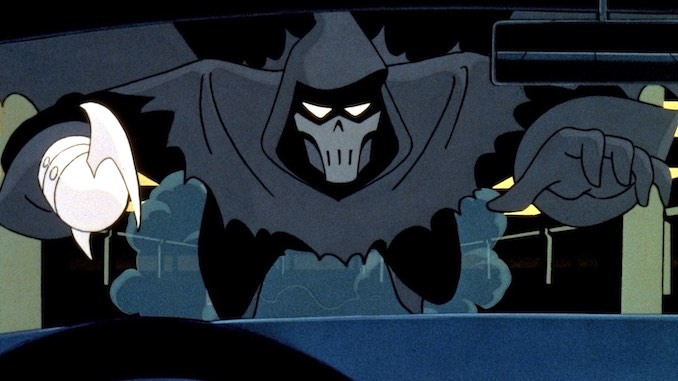Return to Gotham: In His Darkest Movie, Batman Peered Beneath the Mask of the Phantasm
The Animated Series gave Batman his most tragic origin story
Photo Courtesy of Warner Bros. Animation
Editor’s Note: This year, the iconic Batman: The Animated Series turns 30 years old. “Return to Gotham” is a monthly column looking back at the cartoon that remains a touchstone of the superhero genre and one of the most iconic portrayals of The Dark Knight.
![]()
Batman: The Animated Series is a show that makes a reasonable assumption: You know what Batman’s whole deal is. The show’s wordless opening sequence doesn’t even throw up an onscreen title; when the lightning splits the sky, you know who the figure posing atop the skyscraper is. During behind-the-scenes commentary on the three-part pilot of Superman: The Animated Series, the creators (the same guys who brought B:TAS to life), reflected on how they had decided not to bother with a Batman origin story, whereas they felt Superman almost demanded it.
This stands in marked contrast to Batman’s cinematic outings. It’s now something of a joke that we’ve seen Thomas and Martha Wayne gunned down a whole bunch of times—Harley Quinn just riffed on it in a set piece that starts with a flip joke about the whole thing before becoming one of the deepest treatments of Batman since, frankly, this show.
The Animated Series theatrical feature film, 1993’s Batman: Mask of the Phantasm, is different in that it at least spares us that specific scene. (As I’ve mentioned before, the death of Bruce Wayne’s parents is a moment implied by the show to be so awful they can only allude to it.) But it is another Batman origin story, after a fashion. I’m here to tell you that, as Batman origins on film go, it’s the best one, and a worthy addition to a show many people still regard as the best iteration of the character.
It is also, like the show that spawned it, tragic in a way almost no other Bat-film is, save the latter two Christopher Nolan features. It’s a marvel that it wasn’t just made, but that it was as dark and bloody as it turned out to be, and even saw a wide theatrical release. Like so much about the show and its spinoffs and official tie-ins, it feels like the creators got away with something.
Siskel and Ebert (never snobs, and always willing to bring open minds to a movie) both enthusiastically loved this one, particularly the art style—Siskel ranked it just under Tim Burton’s 1989 Batman. It’s a disservice to the film to say that it merely “looks like an episode of the show,” but the characters are completely on-model from their TV iterations, the same voice actors reprise their roles, and the “Dark Deco” look of Gotham City—particularly the entire World’s Fair location, which serves as the set piece of the climactic confrontation—is all perfectly on brand. You can watch Mask of the Phantasm in between the show’s first and second seasons and feel as if you’re watching a cohesive narrative. And yet, right from the title sequence, you can tell the movie is going big. Shirley Walker’s score arrives, for the first time, in a full statement with a choral element for good measure. It sets the tone for a story that ranks as some of the smallest stakes for any Batman movie (nobody’s poisoning Gotham’s water or assassinating its mayor), but seldom have the personal stakes for Batman and Bruce Wayne been as high. The epic framing of the proceedings feels just right.
The movie opens on Batman busting up a casino money-laundering scheme with maximum window-shattering and face-punching. However, as he pursues one of the fleeing mobsters, another masked avenger pops up. But this one doesn’t share Batman’s belief in the sanctity of human life. The Phantasm (Stacy Keach) leaves the mobster dead, but Batman is the masked vigilante the authorities witness on the scene. With his name being dragged through the mud, Batman goes on a hunt for the killer. Bruce Wayne, meanwhile, wonders what connection the Phantasm may have to his former flame, Andrea Beaumont (Dana Delany, making inroads before her later all-time-greatest turn as Lois Lane in the Superman show).
The story flashes back to a younger Bruce Wayne as he meets cute with Andrea (their parents’ graves are next to each other) and eventually begins to question his dedication to fighting crime in light of his growing romance with her. Dating a redhead and fighting crime are, after all, mutually exclusive activities, I explained to my baffled kids (whose mother is a redhead). That story plays in parallel with present-day Batman’s manhunt for the Phantasm, who goes about killing mob bosses with the same theatricality and deception as the Dark Knight at the same time Andrea Beaumont reappears in Gotham.